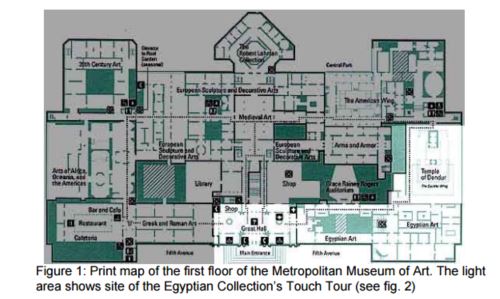Exhibit Design Relating to Low Vision and Blindness: Tactile Mapping for Cultural and Entertainment Venues
I get lost a lot in museums. I sometimes go to check out a particular exhibit, but forget about that after getting distracted by something I’ve noticed along the way. So, I wander around without a clear plan, in hopes of stumbling on something stimulating. While this behavior can lead to serendipitous discoveries and unexpected juxtapositions and overlays, museum staff usually prefers visitors to travel purposefully to destinations where they are likely to learn the most, and to move about in fairly predictable ways. While a certain amount of meandering is to be encouraged, the overall goal of planners is usually to organize things clearly, and to increase the ratio of time spent engaging with exhibits and watching performances over time spent finding things.
Architects, exhibit designers and visitor studies professionals think carefully about wayfinding and orientation when conceiving layouts for museums and other public entertainment venues. They work hard to ensure that visitors will be able to easily locate interesting exhibits and other destinations, like restrooms, cafeteria and (importantly) the gift shop. Still, many visitors find it very challenging to navigate effectively in large facilities, even when consulting a print map that they carry with them. For example, visitors to the Metropolitan Museum in New York often complain about getting lost; given the vastness of the place, it’s not surprising. Most non-locals seeking a specific room or collection at the Met are reduced to finding and asking a member of the museum staff for directions. Obviously, museums are motivated to introduce maps and signage that makes it easier and more intuitive to move about efficiently, providing everyone with a clear sense of their current position in relation to destinations relevant to their interests, and maintaining a good understanding of the extents and shape of the overall building or campus.
Given the challenges that average users report in finding their way in large museums, it is not surprising that visitors with disabilities that interfere with mobility, orientation and reading print signage and graphics find it especially hard to cope, and often avoid museums entirely (Friedman, 2000). Research shows that tactile representations, especially when combined with audio and visuals, can provide print disabled individuals with an improved impression of spaces they occupy and move through (Lederman & Jones, 2006). This paper reports on several existing, and a few more speculative, strategies for presenting multi-sensory way-finding and orientation information. The goal of all of these products and research projects is to create tools that improve visitor satisfaction and learning outcomes at museums, performing arts facilities, and at other entertainment venues.


User Comments/Questions
Add Comment/Question